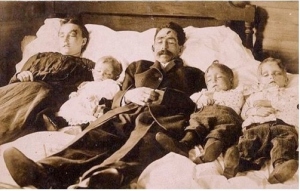Post-mortem photography (also known as memorial portraiture or a mourning portrait) is the practice of photographing the recently deceased. These photographs of deceased love ones were a normal part of American and European culture in the nineteenth and early twentieth centuries. Commissioned by grieving families, postmortem photographs not only helped in the grieving process, but often represented the only visual remembrance of the deceased and were among a family’s most precious possessions.
The invention of the daguerreotype in 1839 made portraiture much more commonplace, as many of those who were unable to afford the commission of a painted portrait could afford to sit for a photography session. This cheaper and quicker method also provided the middle class with a means for memorializing dead loved ones.
Post-mortem photography was very common in the nineteenth century when “death occurred in the home and was quite an ordinary part of life.” Due to photography being a new medium, it is plausible that “many daguerreotype post-mortem portraits, especially those of infants and young children, were probably the only photographs ever made of the ‘sitters.” According to Mary Warner Marien, “post-mortem photography flourished in photography’s early decades, among clients who preferred to capture an image of a deceased loved one rather than have no photograph at all.”
These photographs served as keepsakes to remember the deceased. This was especially common with infants and young children; Victorian era childhood mortality rates were extremely high, and a post-mortem photograph might have been the only image of the child the family ever had. The later invention of the carte de visite, which allowed multiple prints to be made from a single negative, meant that copies of the image could be mailed to relatives.

